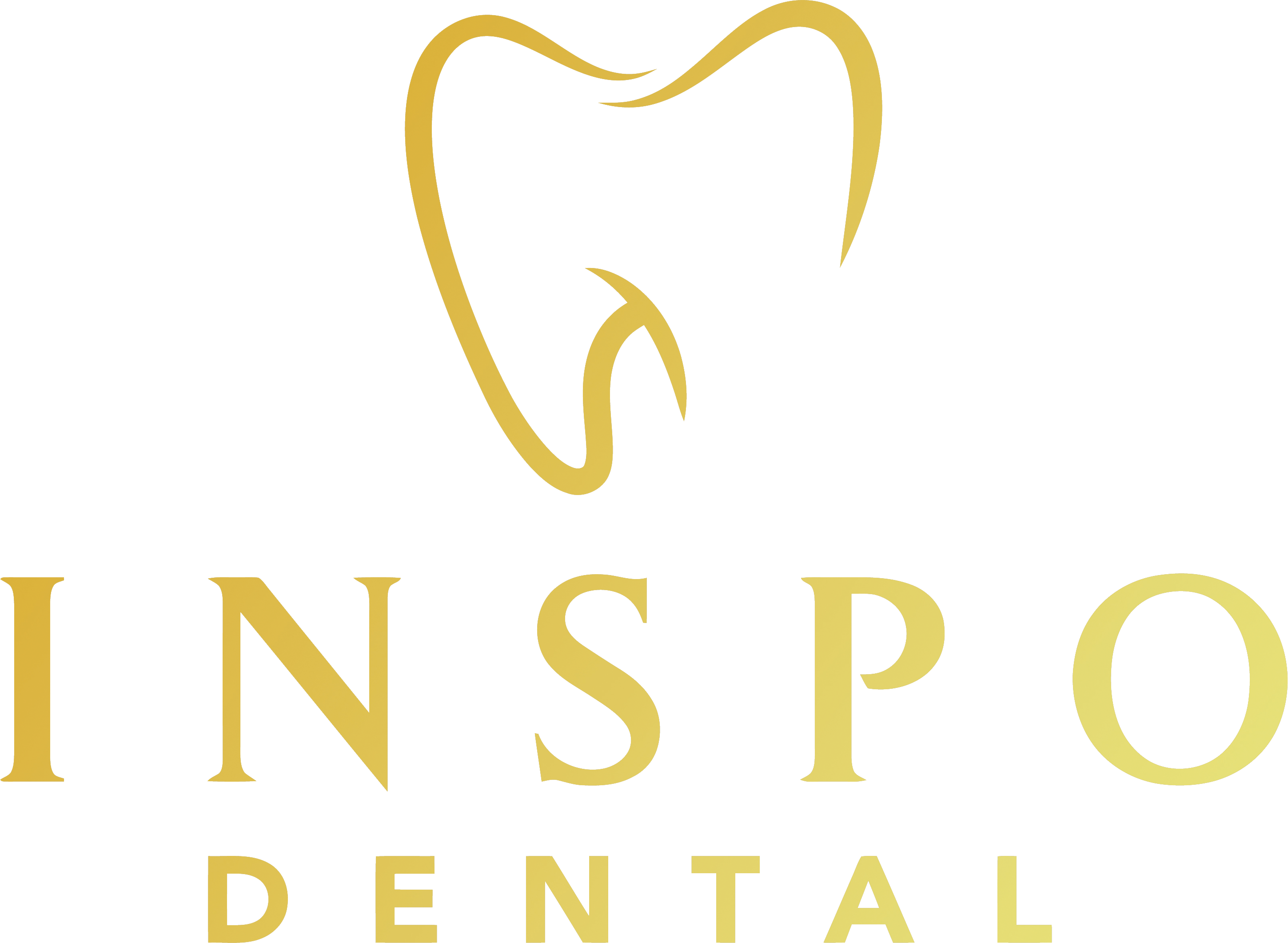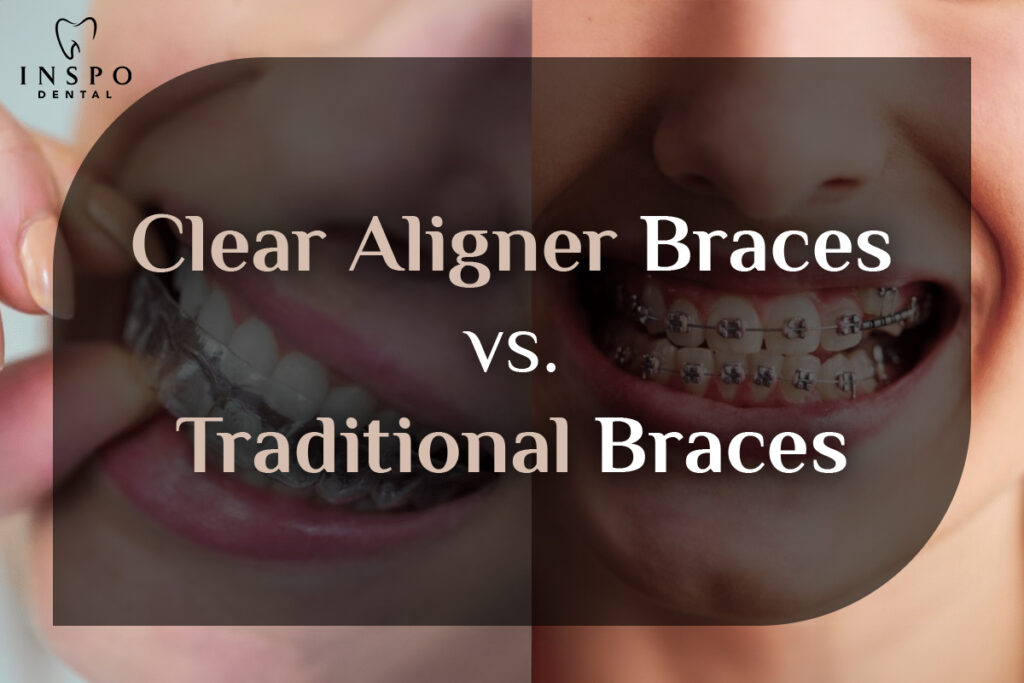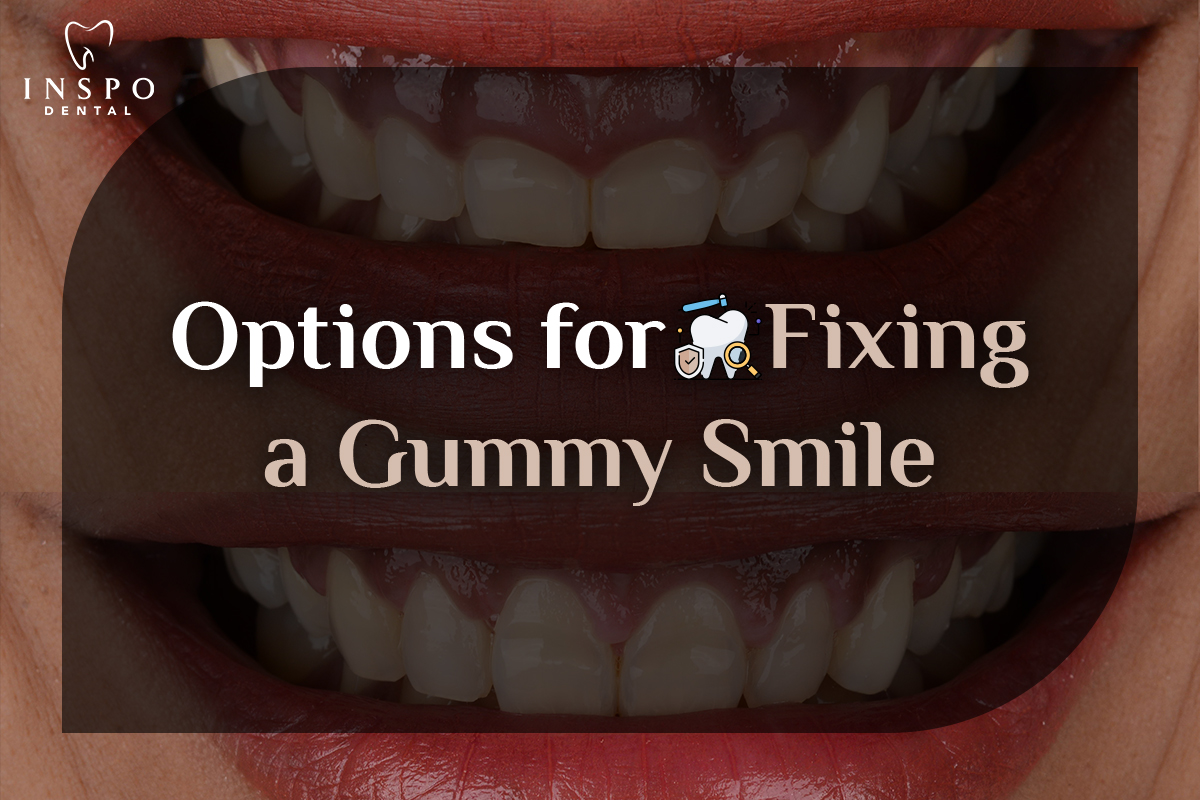When choosing between clear aligner braces (like Invisalign) and traditional metal braces, several factors come into play, including aesthetics, comfort, treatment time, cost, and the complexity of your dental issues. Here’s a comparison to help you decide which might be better for you:
- Aesthetics
- Clear Aligners: Clear aligners are virtually invisible, making them an appealing option for those who prefer a discreet look. They are popular among adults and teens who are conscious of their appearance during orthodontic treatment.
- Traditional Braces: Traditional metal braces are more noticeable. However, there are options like ceramic braces, which are less visible due to their tooth-colored brackets, though they are still more noticeable than clear aligners.
- Comfort
- Clear Aligners: Made from smooth plastic, clear aligners generally cause less irritation to the cheeks and gums compared to metal braces. There are no wires or brackets that might cause discomfort or abrasions.
- Traditional Braces: Metal braces can sometimes cause discomfort due to the brackets and wires. Adjustments can also be uncomfortable, as the pressure on the teeth is manually increased.
- Effectiveness
- Clear Aligners: Clear aligners are highly effective for mild to moderate orthodontic issues, such as crowding, spacing, and minor bite corrections. They may not be as effective for more complex cases or severe misalignments.
- Traditional Braces: Metal braces are typically more effective for treating complex dental issues, including significant bite problems, severe misalignments, and teeth that require significant movement.
- Removability and Convenience
- Clear Aligners: Clear aligners are removable, which makes eating, brushing, and flossing easier. However, they need to be worn for 20-22 hours per day to be effective, and forgetting to wear them can delay treatment progress.
- Traditional Braces: Braces are fixed in place, which means they are always working. This can be more convenient for patients who might forget to wear aligners as prescribed. However, they require careful cleaning and can restrict certain foods to avoid damaging the braces.
- Treatment Time
- Clear Aligners: Treatment time with clear aligners varies but can be shorter for mild to moderate cases, often ranging from 6 to 18 months. The time depends on the complexity of the case and patient compliance.
- Traditional Braces: The treatment time with metal braces can range from 18 months to 3 years, depending on the severity of the dental issues. They are generally more effective for complex cases, which might extend the treatment duration.
- Cost
- Clear Aligners: Clear aligners can be more expensive than traditional braces, depending on the brand (e.g., Invisalign) and the duration of treatment. Costs typically range from $3,000 to $7,000.
- Traditional Braces: Metal braces are usually more affordable, with costs ranging from $2,500 to $6,000. However, the final cost will depend on the length and complexity of treatment.
- Maintenance
- Clear Aligners: Aligners need to be cleaned regularly, and they should be removed when eating or drinking anything other than water. Maintaining good oral hygiene is easier since they can be removed for brushing and flossing.
- Traditional Braces: Metal braces require more diligent oral hygiene to prevent plaque buildup around the brackets. Special tools like interdental brushes or water flossers may be needed to clean around the braces effectively.
- Dietary Restrictions
- Clear Aligners: Since aligners are removable, there are no dietary restrictions. You can eat whatever you like as long as you remove the aligners before eating and clean your teeth before putting them back in.
- Traditional Braces: With metal braces, you need to avoid certain foods, like hard or sticky items, that could damage the braces or get stuck in them. This can be limiting and requires extra care.
- Follow-Up Appointments
- Clear Aligners: Follow-up appointments are generally less frequent with clear aligners. You might only need to visit the orthodontist every 6 to 8 weeks to check progress and receive new sets of aligners.
- Traditional Braces: Regular adjustments are needed with metal braces, typically every 4 to 6 weeks, to tighten the wires and ensure the teeth are moving correctly.
- Suitability for Different Age Groups
- Clear Aligners: Clear aligners are popular among adults and older teens who are more self-conscious about their appearance and prefer a less noticeable option. They are also suitable for individuals who can adhere to the responsibility of wearing the aligners for the recommended hours each day. Aligners are typically not recommended for younger children as they might not have the discipline to wear them consistently.
- Traditional Braces: Traditional metal braces are commonly used for children, teenagers, and adults alike. They are effective for a wide range of ages and dental issues. Since they are fixed, there is no risk of losing them, making them a good option for younger patients who might struggle with the responsibility of removable aligners.
- Impact on Speech
- Clear Aligners: When you first start wearing clear aligners, there may be a slight impact on your speech, such as a lisp. However, most people adjust within a few days to a week. The impact on speech is usually temporary and minor.
- Traditional Braces: Traditional braces may also affect speech initially, especially with certain types of brackets or wires, but this is generally minimal. Most patients adapt quickly to the presence of braces and find that their speech returns to normal relatively quickly.
- Oral Hygiene Challenges
- Clear Aligners: Oral hygiene is easier to maintain with clear aligners since you can remove them to brush and floss your teeth thoroughly. However, it’s important to clean your teeth before putting the aligners back in to avoid trapping food particles or bacteria, which could lead to cavities or gum issues.
- Traditional Braces: Maintaining good oral hygiene can be more challenging with traditional braces. Food can easily get stuck in the brackets and wires, leading to plaque buildup, which increases the risk of tooth decay and gum disease. Patients need to be diligent with brushing, flossing, and possibly using additional cleaning tools like a water flosser or interdental brushes.
- Potential for Damage or Breakage
- Clear Aligners: Clear aligners are durable but can be damaged if not handled properly. Biting down hard or not storing them in a protective case when not in use can lead to cracks or warping. However, since aligners are replaced every few weeks, a damaged aligner is usually not a long-term issue.
- Traditional Braces: Metal braces are quite durable, but the brackets or wires can break if you eat hard or sticky foods, or if you suffer an impact to the mouth. Repairs or adjustments may be needed, which can extend treatment time and require additional visits to the orthodontist.
- Treatment Flexibility
- Clear Aligners: Clear aligners offer more flexibility in terms of lifestyle. Because they are removable, you can continue to enjoy your favorite foods and maintain your usual oral hygiene routine. However, this flexibility requires discipline; not wearing the aligners as prescribed can delay treatment progress.
- Traditional Braces: Traditional braces are less flexible in terms of lifestyle adjustments. You’ll need to be careful about what you eat and may need to adopt new tools and techniques for oral hygiene. However, because they are always working, there’s no risk of treatment delay due to not wearing them.
- Social and Psychological Considerations
- Clear Aligners: Many people choose clear aligners for the psychological comfort they provide due to their discreet appearance. This can be especially important for adults and teens who may feel self-conscious about wearing braces.
- Traditional Braces: While traditional braces are more noticeable, they are also widely accepted, especially among younger patients. Some may even see them as a rite of passage. However, for those concerned about appearance, especially in professional or social settings, the visibility of metal braces can be a drawback.
- Follow-Up Care and Retention
- Clear Aligners: After completing treatment with clear aligners, you will likely need to wear a retainer to maintain the new position of your teeth. In some cases, the last set of aligners can double as retainers, which provides continuity in care. Retainers are crucial to prevent teeth from shifting back to their original positions.
- Traditional Braces: Similarly, after traditional braces are removed, you will need to wear a retainer to ensure that your teeth remain in their new positions. Retainers are often recommended to be worn full-time initially and then gradually reduced to nighttime wear.
- Environmental and Ethical Considerations
- Clear Aligners: The production and disposal of clear aligners can raise environmental concerns. Since aligners are replaced frequently, there is a higher level of plastic waste associated with this treatment. Some companies are beginning to offer recycling programs, but the environmental impact is still a consideration.
- Traditional Braces: Traditional metal braces have a smaller environmental footprint in terms of waste since they are not replaced as frequently. However, the metals and materials used also have their own environmental impacts during production.
- Technology and Innovation
- Clear Aligners: Clear aligner technology is rapidly evolving, with improvements in materials, customization, and treatment planning. Digital scans and 3D printing are commonly used to create highly personalized aligners, improving comfort and effectiveness. Some companies even offer remote monitoring, reducing the need for frequent in-office visits.
- Traditional Braces: While traditional braces have been around for a long time, they too have benefited from advancements in technology. Innovations such as self-ligating brackets, which reduce friction and potentially shorten treatment time, and new materials that improve comfort and effectiveness, continue to evolve.
- Suitability for Specific Dental Conditions
- Clear Aligners: Clear aligners are best suited for mild to moderate cases of misalignment, spacing, and crowding. They are also effective for certain bite issues like minor overbites, underbites, or crossbites. However, they may not be the best option for complex cases that require significant tooth movement.
- Traditional Braces: Traditional braces are often recommended for more complex orthodontic issues, including severe crowding, large gaps, significant bite problems, and cases where teeth need to be rotated or moved vertically. Braces can apply more force than aligners, making them better suited for challenging cases.
- Impact on Oral Health During Treatment
- Clear Aligners: One of the advantages of clear aligners is that they allow for better oral hygiene during treatment. Since they are removable, you can brush and floss your teeth as usual without any obstructions. This can help prevent common issues like plaque buildup, cavities, and gum disease, which are more challenging to manage with traditional braces.
- Traditional Braces: With traditional braces, maintaining oral hygiene can be more challenging. Food particles can easily get trapped in the brackets and wires, making it difficult to clean the teeth thoroughly. Patients with braces are at a higher risk of developing plaque buildup and cavities if they do not adhere to a rigorous oral hygiene routine. Orthodontists often recommend special toothbrushes, floss threaders, or water flossers to help maintain oral health during treatment.
- Dietary Considerations During Treatment
- Clear Aligners: One of the significant benefits of clear aligners is that they are removable, so you can eat whatever you like without restrictions. There’s no need to avoid hard, sticky, or chewy foods that could potentially damage braces. However, you must remember to remove your aligners before eating and to brush your teeth before putting them back in to avoid trapping food particles that could lead to tooth decay.
- Traditional Braces: With traditional braces, you need to be more mindful of your diet. Certain foods, like hard candies, nuts, popcorn, and sticky treats like caramel, should be avoided as they can damage the braces or get stuck in the wires and brackets. Chewing gum is also typically off-limits. These dietary restrictions can be a downside, especially for younger patients who may find it challenging to give up their favorite snacks.
- Treatment Time Predictability
- Clear Aligners: The treatment time with clear aligners can be more predictable, as it is often based on a pre-determined number of aligners and the specific movements planned by your orthodontist. However, compliance plays a critical role—if aligners are not worn for the recommended hours each day, treatment time can extend beyond the initial estimate.
- Traditional Braces: While traditional braces are highly effective, the treatment time can be less predictable, particularly in complex cases. The orthodontist needs to make periodic adjustments to the wires, which may require additional visits or longer treatment periods if the teeth do not move as expected.
- Impact on Daily Life
- Clear Aligners: Clear aligners generally have a minimal impact on daily life. Since they are virtually invisible, most people won’t even notice you are wearing them, allowing you to go about your social, professional, and personal life with confidence. However, you will need to remove the aligners before eating or drinking anything other than water, which can be inconvenient in certain situations, like dining out or attending social events.
- Traditional Braces: Traditional braces can have a more noticeable impact on daily life, especially when it comes to appearance. Some individuals may feel self-conscious about wearing metal braces, particularly in social or professional settings. Additionally, the discomfort that can occur after adjustments may affect your daily routine temporarily.
- Sports and Physical Activities
- Clear Aligners: For individuals who play contact sports, clear aligners can be a convenient option. Since they are removable, you can take them out during games and practices, reducing the risk of injury. However, it’s essential to wear a protective mouthguard if you’re engaging in activities where there is a risk of impact to the mouth.
- Traditional Braces: While traditional braces can also be worn during sports, it’s crucial to wear a specially designed mouthguard to protect the braces and your mouth from injury. The brackets and wires can potentially cause cuts or other injuries to the inside of your mouth if you suffer a blow during physical activity.
- Travel and Lifestyle Considerations
- Clear Aligners: If you travel frequently, clear aligners may offer more convenience. You can bring your aligners with you and continue your treatment without the need for frequent orthodontic visits. However, you’ll need to be diligent about keeping track of your aligners and making sure they are worn for the recommended amount of time each day.
- Traditional Braces: Traditional braces require regular orthodontic appointments for adjustments, which might be less convenient for individuals who travel often. If a bracket or wire breaks while you’re away, it could be challenging to get it repaired quickly. However, traditional braces do not require the same level of daily management as clear aligners.
- Long-Term Considerations After Treatment
- Clear Aligners: After completing treatment with clear aligners, you may need to wear a retainer, similar to traditional braces, to maintain your results. Some clear aligner systems offer a final set of aligners that can act as a retainer, providing continuity. Regular wear of retainers is essential to prevent teeth from shifting back to their original positions, which is a risk with any orthodontic treatment.
- Traditional Braces: Post-treatment retention is also crucial with traditional braces. You’ll typically be given a retainer to wear, either a removable one or a permanent retainer that is bonded to the back of your teeth. The commitment to wearing a retainer is the same regardless of whether you had traditional braces or clear aligners.
- Aesthetic Appeal Over Time
- Clear Aligners: The aesthetic appeal of clear aligners remains consistent throughout the treatment, as they are designed to be virtually invisible. However, if you don’t clean the aligners properly, they can become discolored or develop a slight odor, which might affect their appearance.
- Traditional Braces: While traditional braces are visible, some patients choose to customize them with colored bands, making them more personalized and fun, especially for younger patients. Over time, the visibility of braces doesn’t change, but you might experience some staining on the teeth around the brackets if oral hygiene is not maintained properly.
- Communication and Speech Adjustments
- Clear Aligners: Clear aligners may cause a slight lisp or speech alteration when you first start wearing them, but this typically resolves as you adjust to having them in your mouth. Since they are custom-fitted, most users find that any speech changes are minimal and temporary.
- Traditional Braces: Traditional braces can also affect speech, particularly when first applied. The brackets and wires may cause difficulty in pronouncing certain words or sounds, but most patients adapt over time. Speech is usually not a significant issue once you become accustomed to the braces.
- Patient Compliance and Accountability
- Clear Aligners: Clear aligners require a high level of patient compliance. You need to wear them for 20-22 hours a day and must remember to remove them before eating or drinking anything other than water. Forgetting to wear them consistently can lead to delays in treatment, making patient accountability critical to the success of the treatment.
- Traditional Braces: Traditional braces do not rely on patient compliance in the same way because they are fixed to your teeth. However, maintaining good oral hygiene and adhering to dietary restrictions are essential to avoid complications. Compliance with attending regular orthodontic appointments is also important to ensure progress is monitored and adjustments are made as needed.
- Patient Autonomy and Control
- Clear Aligners: Clear aligners give patients more control over their treatment, as they can remove the aligners when necessary. This autonomy can be beneficial for adults who need to adapt their treatment to their lifestyle, such as for professional meetings or social events. However, this control also requires a high level of discipline to ensure treatment stays on track.
- Traditional Braces: With traditional braces, the orthodontist has more control over the treatment process. Once the braces are in place, they work continuously, and adjustments are made during regular appointments. This can be beneficial for patients who prefer not to manage their treatment actively.
- Aging and Orthodontic Treatment
- Clear Aligners: For older adults considering orthodontic treatment, clear aligners are often an attractive option because of their discreet appearance and minimal impact on lifestyle. Age-related dental issues, such as gum recession or bone loss, might influence the decision, and clear aligners can sometimes be a gentler option.
- Traditional Braces: Traditional braces are effective at any age but may require additional care and attention in older adults due to factors like gum health and bone density. Orthodontists can adapt the treatment plan to address these concerns, but patients should be prepared for a potentially longer treatment time if more complex dental issues are present.
- Considerations for Teens and Young Adults
- Clear Aligners: For teenagers, clear aligners offer a more aesthetic option, which can be important during formative years when self-esteem and appearance are significant concerns. Aligners also eliminate the need for frequent orthodontic visits, which can be more convenient for busy school and extracurricular schedules. Some aligner systems even include features that track wear time, ensuring that teens are compliant with their treatment.
- Traditional Braces: Traditional braces are often the go-to for teens, particularly because they can address a wide range of orthodontic issues effectively. They are fixed, meaning compliance is less of an issue compared to aligners. Parents may also feel more comfortable with traditional braces since they do not rely on the teen’s ability to remember to wear them.
Final Decision-Making Considerations
When making your final decision between clear aligners and traditional braces, consider the following steps:
- Consult with an Orthodontist: Start with a thorough consultation with a qualified orthodontist who can assess your dental needs and recommend the most effective treatment plan. They will take into account factors such as the complexity of your case, your age, and your lifestyle preferences.
- Evaluate Your Lifestyle: Reflect on how each option will fit into your daily life. Consider your ability to maintain oral hygiene, your willingness to comply with treatment requirements, and how much you value discretion in your appearance.
- Consider the Long-Term Outcome: Think about the long-term benefits of each treatment option. While clear aligners may be more convenient and aesthetically pleasing, traditional braces might offer a more comprehensive solution for complex cases.
- Budgeting and Insurance: Check with your orthodontist about the cost of each treatment and whether your dental insurance covers any portion of it. Some insurance plans may have different coverage levels for clear aligners versus traditional braces.
- Get a Second Opinion: If you’re uncertain, consider getting a second opinion from another orthodontist. This can provide additional insights and help you feel more confident in your decision.
Conclusion
Choosing between clear aligners and traditional braces involves weighing various factors, including aesthetics, comfort, effectiveness, cost, and personal lifestyle. Clear aligners offer a modern, discreet, and convenient option for those with mild to moderate orthodontic issues and who are disciplined enough to wear them consistently. Traditional braces, on the other hand, provide a tried-and-true method for addressing more complex dental issues and require less day-to-day management.
Ultimately, the best choice depends on your specific needs and preferences. By thoroughly discussing your options with an orthodontist and considering the long-term implications of each treatment, you can make an informed decision that leads to a healthy, beautiful smile.






